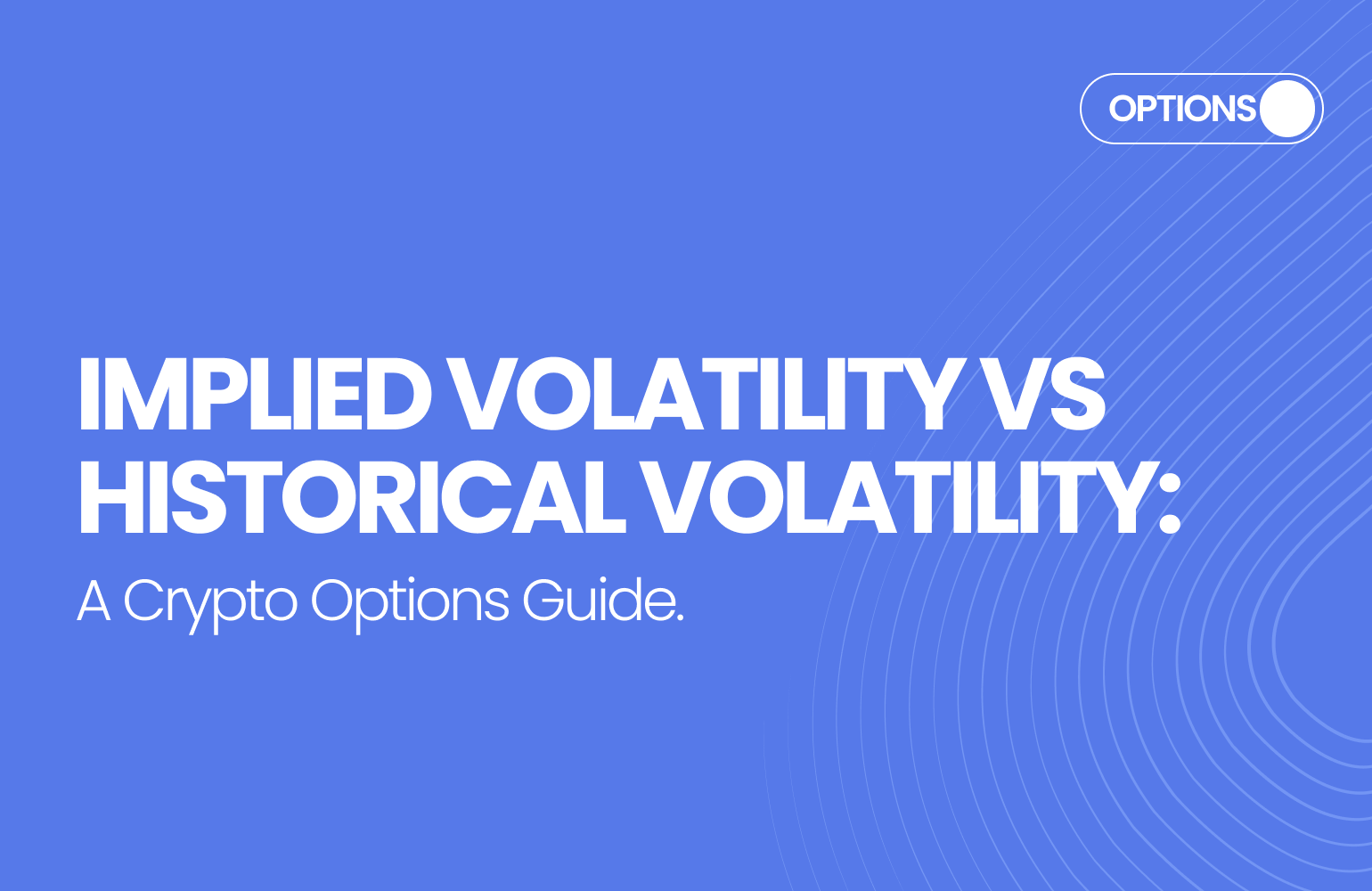Key Takeaways:
- IV = market forecast; HV = past behavior
- Compare IV to HV to find mispriced opportunities
- Use IV for trade entries and risk-adjusted strategies
Crypto prices move fast. But smart traders don’t just react to price, they understand volatility. If you’re diving into crypto options, two volatility measures matter most: implied volatility vs historical volatility.
Implied volatility reflects market expectations, while historical volatility measures actual past moves. Understanding how they differ, and how to use them, can dramatically improve your timing, risk management, and profitability. In this article, we break down IV and HV, how they affect options pricing, and how to use both to build better trades.
What Is Implied Volatility (IV)?
What is implied volatility in options? It reflects the market’s expectations of how volatile an asset will be in the future. It’s derived from current options prices using pricing models like Black-Scholes.
Why It Matters
- Higher IV = higher option premiums
- IV rises when traders expect big moves (up or down)
- IV doesn’t predict direction, just magnitude
Example: If BTC is trading at $60,000 and IV rises sharply before a CPI announcement, the market is bracing for a move, but doesn’t know which way.
IV in Crypto
Implied volatility crypto is typically higher than stocks due to 24/7 trading and news sensitivity. BTC and ETH options often show IV spikes before major events (e.g., ETF approvals, regulatory changes).
Read More: Trading With Implied Volatility Options in Crypto
What Is Historical Volatility (HV)?
What Is Historical Volatility? It measures how much an asset’s price has actually fluctuated over a specific past period, usually 7, 14, or 30 days. It’s based on the standard deviation of daily returns.
Why It Matters
- HV gives context to current price stability or chaos
- Helps traders assess whether current IV is overpriced or underpriced
Example: If BTC has moved ±5% daily over the past two weeks, its 14-day HV might be 80%. If IV is only 50%, the option might be underpriced.
HV in Crypto
HV in crypto can change dramatically after news, hacks, or liquidations. Low HV + high IV = potential premium-selling opportunity.
Difference Between IV vs. HV
| Feature | Implied Volatility (IV) | Historical Volatility (HV) |
|---|---|---|
| Definition | Future expected volatility | Past realized volatility |
| Derived From | Option premiums | Price movement history |
| Affects Pricing? | Yes (direct input to premium) | No (used as reference) |
| Directional Info | No | No |
| Updated | Real-time | Daily/hourly depending on source |
| Strategy Application | Option pricing, trade entry | Mean-reversion, IV comparison |
The IV vs HV comparison shows IV drives option pricing today, while HV validates whether that pricing is fair.
How IV and HV Affect Crypto Options Pricing
IV Drives Premiums
Higher IV = more expensive options. Traders buying options should avoid high IV unless expecting further spikes. Sellers love high IV for collecting bigger premiums.
Compare IV vs. HV for Edge
- IV > HV: Options may be overpriced → Consider selling premium
- IV < HV: Options may be underpriced → Consider buying options
This highlights the difference between implied volatility and historical volatility, and why it matters in execution.
Practical Example (BTC Options)
- BTC Spot: $60,000
- 7-day HV: 40%
Current IV: 75%
Traders may sell a straddle to profit from high IV, expecting BTC to stay range-bound.
How to Use IV and HV in Your Trading Strategy
- Entry Timing
Buy options when IV is low (cheaper entry). Sell options when IV is high (premium collection).
- Choose the Right Strategy
High IV? Use credit spreads, iron condors, covered calls.
Low IV? Try long calls/puts or debit spreads.
This is where the difference between implied and historical volatility becomes your trading edge.
- Manage Risk Better
- Don’t just look at price, check volatility trends too.
- Use HV to backtest expected behavior and range.
- Use IV Rank and IV Percentile
- IV Rank = Where current IV stands relative to its 1-year range
- IV Percentile = How often current IV has been lower over the past year
Pro Tip: On Pi42 and other pro platforms, look for IV overlays and dashboards to guide setups in implied volatility in crypto and historical volatility in crypto trading.
Tools to Track IV and HV
- Pi42 Options Chain: Shows live IV by strike
- TradingView Indicators: Use HV-based custom scripts
- Greeks + IV Surface Tools: Available on Deribit or professional terminals
Recommended Settings:
- HV periods: 7-day, 14-day, 30-day
- IV check: Pre- and post-announcement windows
Conclusion
In crypto options trading, implied volatility vs historical volatility are more than technical terms, they’re strategic weapons. Knowing when volatility is cheap or expensive helps you time trades, choose strategies, and manage risk.
Ready to put volatility to work? Trade smarter using IV insights on Pi42, India’s leading crypto options platform.
Keep Learning
What Is Options Trading in Crypto? Simple Guide for Beginners
Crypto Market Making: Understanding the Role and How It Works

